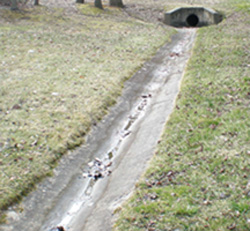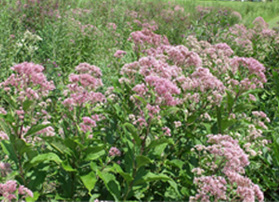Fact Sheet FS1195
What Is a Detention Basin?
Detention basins, also known as dry ponds or dry detention basins, are stormwater management structures designed to slow down stormwater runoff for a period of time to decrease downstream flooding from larger precipitation events. Unlike wet ponds (also known as "retention basins"), detention basins are not designed to have large permanent standing pools of water, but are designed to infiltrate water (soak into the ground) or drain to a stream within a determined period of time (usually 72 hours). Over the last 30 years, detention basins have been commonly used in suburban developments to provide flood control during storm events.
Why Retrofit a Detention Basin?
Many existing stormwater basins in New Jersey were built prior to the mid 1980s and were designed with the single purpose of providing flood control. These basins function by capturing stormwater from rain events and snowmelts, and then slowly release this water to a receiving stream or stormwater channel. This action effectively mitigates flooding by both decreasing peak flows downstream and delaying the timing of those peaks. Particularly in densely populated areas, it has been suggested that this style of basin could be improved to contribute to green infrastructure goals.
Limitations of the traditional or common style of dry detention basin include:
- Often have a reduced ability of basins to infiltrate water due to compacted soil. Infiltration is the process of water soaking into the soil. Water can be stored in soil and available for plant growth, or it can continue to make its way deeper underground into groundwater and aquifers. Compacted soil makes it harder for stormwater to enter the soil, so more water moves down slope as runoff, carrying nutrients and sediments, or in level areas, may form ponding on the surface. While this style of basin slows water to decrease downstream flooding, they often do not allow much of the detained water to infiltrate into the soil. One cause of this is that the soil in the bottom of these basins may become overly compacted during construction. Infiltration of precipitation and runoff water is an important green infrastructure goal, since infiltration recharges groundwater, decreases total runoff, and helps remove pollutants from the water.
- The inability of basins to treat small runoff events. Since dry detention basins often contain a concrete low flow channel, runoff from smaller storms typically flows directly through the basin without treatment. Although concrete low flow channels were intended to minimize habit for mosquito breeding by eliminating small pools of standing water, these channels also limit infiltration during small storms. Given that 90% of the storms in New Jersey are less than 1.25 inches of rainfall (Clayton and Schueler 1996), a significant volume of water passes through these basins without treatment or the opportunity to infiltrate into the basin soil.
- Encourages nuisance species. These detention basins are typically planted with a turf grass that is mowed on a regular basis. This creates large areas of habitat or resting places for nuisance wildlife such as Canada geese. Geese can defecate up to 1 ½ pounds of fecal material per day causing a mowed basin to become an increasing source of bacteria in the watershed.
- High maintenance costs. Since these basins typically have turf grass cover, their landscape maintenance represents a significant investment in labor and resources for the municipal, county, or private owners.
These limitations may be overcome by modifying the basin to allow water to spread beyond the concrete channel and by planting native or other deep-rooted herbaceous vegetation. Such vegetation can improve the infiltration and filtration (pollutant removal) of stormwater runoff (Winer 2000). Furthermore, such vegetation reduces mowing frequency to perhaps once per year, a great savings of time, effort, and money to the landowner. Finally, this vegetation provides habitat for desirable wildlife species and provides ecological benefits.
Who Retrofits the Basin?
Detention basins are typically owned by a municipality, county, or managed by a residential development as community property. It is important to work with public officials to ensure that public safety and all applicable design restrictions are considered during the retrofitting process.

Figure 1. Detention basin.
How to Retrofit a Basin
A good basin to retrofit would be one that has:
- short turf-type vegetation from regular mowing;
- a low flow concrete channel (fig. 1);
- a discharge orifice greater than 3 inches;
- is not used for other purposes when dry.
It is also important to consider the depth to groundwater where the basin is sited so that the potential infiltration is maximized. Soil that has groundwater close to the surface is likely to stay wet long after rain events and not infiltrate much water.
One of the main goals with retrofitting a basin is to get more of the stormwater runoff to spread out across the basin bottom to increase infiltration and filtration by the vegetation. This can be accomplished by one or more of the following methods: 1) removing the concrete low flow channel and replacing it with vegetation or stone; 2) placing a structure across the channel to deflect the stormwater out into the basin (Fig. 2); or 3) modifying the outlet structure (Emerson et. al. 2005). At this stage, assessing the infiltration capacity, compaction, organic matter, and chemical properties of the soil is helpful to determine if soil amendments or loosening of the soil would be beneficial (Mangiafico, 2011).

Figure 2. Deflecting stormwater out into the basin.
Any number of vegetation types can be appropriate replacements for high-maintenance turfs. These include native grasses, a wildflower mix, or other herbaceous vegetation planted in the basin bottom (Fig. 3). It is essential that local climate, weather, soils, and vegetation be considered when timing the planting of vegetation. Bare soil should be minimized, especially during rainy weather to prevent soil erosion and downstream sedimentation. However, planting should be timed to maximize the chances of establishment of the new vegetation. Appropriate erosion-control and sediment-capture methods should be used where needed. Likewise, alternative seed-planting techniques should be considered, including: 1) removing the sod layer and replanting with seed; 2) "drilling" seed through the existing grass; or 3) planting plugs of new herbaceous plants into the existing bottom. As a practical note, place any shrubs as clumps or "islands" and not spread out through the basin. This is helpful to prevent them from being mowed down during annual maintenance.

Figure 3. Vegetation planted in the basin bottom.
This process of naturalization and habitat enhancement should have support of the local residents, and residents should be educated about the benefits of the new planting to ensure its acceptance. After the initial installation of any structures or "hardscaping" to modify flow, volunteers can aid in planting of the native vegetation with guidance and support from experienced staff.
Maintenance
Instead of weekly or bi-weekly mowing, properly retrofitted basins need only be mowed once a year, preferably in late fall after the first frost. By not mowing during the growing season, the mature vegetation can improve wildlife habitat and provide ecological benefits. Allowing the vegetation to grow and flower will enable birds and native pollinators to utilize this "urban refuge" for feeding, habitat, and for some species, reproduction (Fig. 4). If possible, mowing when the ground is frozen will prevent or greatly reduce compaction and rutting from equipment in the basin bottom.
Sediment accumulation in the basin may be allowed, but should be evaluated on a site-by-site basis to ensure that the flood control capabilities of the basin remain intact.

Figure 4. Native pollinators.
Regulatory Considerations
It is important to determine the regulatory approvals needed prior to retrofitting any detention basin. There are federal, state, county, and municipal stormwater regulations to consider. Often it is required to provide evidence the basin will maintain its original flood control function after the retrofit. Check with the municipal engineer to determine how basins are regulated in your community. If the retrofit will reduce maintenance costs, many municipal engineers will provide technical support for the project. This review will reduce the liability to the group proposing the retrofit by ensuring the proposed modifications to the basin will not affect its ability to detain water as originally designed.
Mosquitoes
Any stormwater management process must consider the public health issue of mosquito habitat. Since mosquitoes like to exploit stagnant, nutrient-rich water for breeding, an important basin design criterion is that the basin should not hold standing water longer than 72 hours (Metzger 2004). Also, the outfall structures on these basins should incorporate a drainage orifice that is difficult to clog. Basin designs that incorporate ecological diversity using suitable habitat to enhance natural mosquito predators are highly encouraged (Megonigal 2009).
Conclusions
The desired result of a successful detention basin retrofit is to slow down stormwater runoff and provide the time and space for the water to infiltrate into the ground, while providing necessary flood protection. Native vegetation can allow a site to serve as a place for environmental education while providing the local community with increased ecosystem diversity.
An additional benefit of the basin retrofits is the potential maintenance cost savings due to reduced mowing schedules and reduced consumption of resources for mowing (Blaine and Smith 2006). These savings can be substantial for local municipal governments. Some public works directors have reported savings of up to $4,000 per year in reduced maintenance costs for each basin retrofitted.
References
November 2012
Copyright © 2025 Rutgers, The State University of New Jersey. All rights reserved.
For more information: njaes.rutgers.edu.
Cooperating Agencies: Rutgers, The State University of New Jersey, U.S. Department of Agriculture, and Boards of County Commissioners. Rutgers Cooperative Extension, a unit of the Rutgers New Jersey Agricultural Experiment Station, is an equal opportunity program provider and employer.

